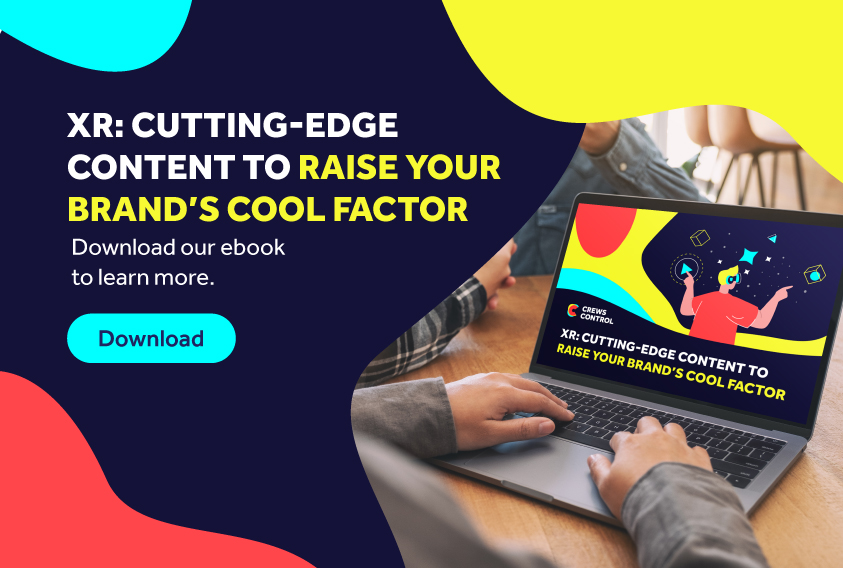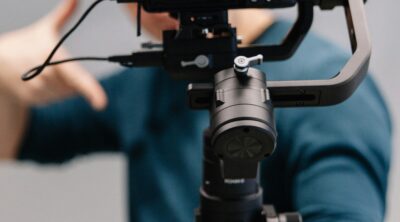< Back to all posts
Production of Virtual Reality, Augmented Reality and Other Extended Reality Content
Whenever there’s an exciting new phenomenon in brand content, it’s natural to ask, “How can my company do that?” Jumping onto new trends while they’re still fresh can be especially exciting, allowing your marketing materials, training content and more to stand out from competitors.
Extended reality (XR) content has recently reached a new level of ubiquity, meaning it’s time to start thinking about whether you should make it part of your strategy, and figure out the best way to produce these immersive materials. XR is a blanket term that includes both virtual reality (VR) and augmented reality (AR), each of which could help your company make a splash with your target audience.
While creating great XR content does require specialized technology and expertise, it’s not out of reach for your business, especially when you team up with expert content creator teams. While immersive experience content may become fully normalized within a few years, it is currently cutting edge, making this a perfect time to start exploring the possibilities of XR.
What Are the Top Uses of XR Content in Today’s Corporate World?
VR and AR are already parts of companies’ video marketing, training and communications offerings, at least in a limited capacity. Early adopters have found use cases that show the value of creating an immersive experience or otherwise changing up the ways in which viewers interact with video.
Habits for consuming XR content differ between VR and AR, which has helped organizations decide which option works for them.
Experiencing VR is best suited to solitary audience members engaging in the virtual world through a headset. This can make it a good fit for worker training or virtual convention attendance, among many other uses. Companies’ push to create fully digital metaverse experiences shows the potential next steps for VR technology and content.
Early corporate use cases for VR content include:
- Deep immersion training: When training employees in potentially dangerous situations, companies need ways to introduce those scenarios without putting their trainees in harm’s way. As Training Industry explains, a VR solution could shine in this role, creating a realistic version of any setting.
- Product development: How can companies know what customers will think of their products before they build physical prototypes? Information Age suggests they can create virtual versions and test users’ reactions — Ford has already embraced this approach for new vehicle testing.
- The sales process: Helping customers pick out new products is a valuable use case for VR technology. Business.com explains that Audi dealers have begun using VR to let shoppers customize and try vehicles. For an added “wow” factor, buyers can set the VR experience in a location of their choice, including the surface of the moon.
AR technology involves placing visual elements into real-world situations. Right now, it normally involves smart devices, using cameras and screens to project a version of the immediate surroundings with added digital content. This type of content got a major visibility boost when the mobile game Pokemon GO became a phenomenon.
AR content has been used in situations such as:
- Augmented training: Educating employees or consumers is an important use case for AR content, with lessons and information directly overlaid on real-world situations. Business.com notes that Walmart and Chipotle are already using AR training.
- Shopping: With AR technology, home shoppers can project furniture into their homes, or clothes onto their bodies, to see how it will look in real life. Future Business Tech reports that this so-called “virtual fitting room” tech could be a $10 billion industry by 2027.
- Tourism and guidance: When a brand is hoping to guide users through a location or an experience, it can get its point across with AR prompts. Or, as Inc. suggested, travel organizations can use AR content to preview destinations for customers, so they can get familiar with a place before they go there.
After pondering the potential use cases of VR and AR technology, it’s time to take the next step and start producing some of this content for your brand. Of course, crafting an immersive experience is not a simple matter of pointing a camera at a landscape. With the right combination of tech and expertise, however, your brand can jump into VR and AR usage.

How Do Brands Produce Virtual Reality Content?
Crafting a VR experience is an involved process because of the nature of VR content. Users wearing a VR headset are immersed in a 3D world. That means you should be ready to craft a virtual environment that extends a full 360 degrees, along with a soundscape that will make users believe they are really in that digital world.
Planning and beginning the project
Given the complexity of VR content creation, it’s important for brands to have a strong vision when they begin working with virtual reality technology. As the BBC explains, this means interrogating the project’s objectives and purpose.
You should know why a VR solution is right for you — what is your brand gaining from immersing users in this environment? Are you making a sales experience more compelling, or creating a more realistic training scenario for a process that demands close attention?
There is also the matter of interactivity. There are some important questions to ask here, too, according to the BBC. How much control will users have over the virtual world? Are you comfortable with the fact that you cannot control the pacing of a self-guided VR experience the same way you would with a narrative-based, two-dimensional fim?
Filming and generating content
Actually creating a 3D virtual reality world will likely involve blending several types of content. VR Direct notes that these elements may include 360-degree video footage, 3D models and 2D heads-up display icons, all of which have to integrate smoothly to create a cohesive, immersive experience for viewers.
The balance of video footage, 3D models and 2D content will depend on the type of experience you’ve planned and envisioned. Whereas building Audi’s “car customization on the moon” scenario involved modeling the lunar surface, a more mundane virtual showroom could be created by capturing 360-degree footage in an actual store.
Audio is another important piece of the puzzle. Both VR Direct and the BBC note that audio cues can guide a user through a VR experience. The use of effective sound effects and music will tell viewers whether they are on the right track when they’re moving through the virtual world. On the other hand, a lack of immersive audio could take viewers out of the content and make them less engaged with everything around them.
The challenges associated with creating VR content come from the fact that you’re attempting to craft an immersive experience. One out-of-place element that brings down a project’s visual or audio quality can have a major, detrimental effect on the end result.
Such difficulties don’t mean it’s a bad idea to work with VR, but they do mean you should be prepared to invest significant time, budget and effort into the project. Partnering with video experts is a way to bring in the necessary level of polish without taking on numerous extra salaries or equipment costs.
How Do Brands Produce Augmented Reality Content?
Producing AR content means creating elements that will be overlaid on the real world. In some ways, this makes the process simpler than VR content creation — after all, in VR, creators must produce the whole environment. However, the nature of AR content does introduce its own challenges. To create the illusion of an immersive experience, the augmented reality elements must fit into the real-world setting.
Crafting an AR strategy
The first step in building AR content is deciding what type of experience you want your users to have. Will they be using the AR technology in a specific location, such as your company’s store, or is it designed to create an experience around them wherever they are?
MobiDev’s Andrew Makarov, writing for Smart Insights, gave a few examples of each type of strategy. For instance, Pepsi launched a consumer-focused ad campaign that used its bus stop ads as a backdrop for AR content. On the other hand, StubHub crafted a virtual model of a stadium, allowing potential ticket buyers to project the view from various sections of the stadium in front of them.
Building 3D models and other AR content
Once you’ve decided what you’re planning to accomplish with your strategy, you can start generating the content itself. This may involve 2D video overlaid on environments, 3D models that exist in those spaces, or a combination of the two. As with VR content, elements such as sound design are also important to complete the experience.
Harvard Business Review describes some of the properties that can make virtual objects interface smoothly with the world viewers see around them. First, the AR content must conform to the real-world spaces, and stay in place when the user moves the camera, so the AR app should be able to sense the geometry of the world. This is the technology that makes furniture in the IKEA experience look like it’s really in a user’s home.
Creators also need to think about how their content will sound and move. HBR suggests that sound, shadows and lighting are key to making AR content feel real, but that motion is more complex. Too much movement on 3D AR elements can take users’ eyes off of their real surroundings.
Developing AR content takes a specific set of skills — it’s normal for companies to not have personnel with a suitable background. Expert video production agencies, however, can bring this skill set into the fold.
Why Work with Experts for Your XR Content Production?
Hiring an expert team of video production personnel is a way to add new capabilities without creating a whole new department within your organization. These experienced content creator teams are on top of the latest trends in the world of content, and are equipped with the technology to bring your vision to life, even when you’re working in cutting-edge spaces such as XR.
If you’re ready to delve into VR or AR content, you can download our ebook on the best uses of this technology, or reach out to Crews Control directly and discover your ideal next steps.






We’ve used it once to map out an event venue, and it was such a great experience. Having a virtual sample of it makes it easier to visualize